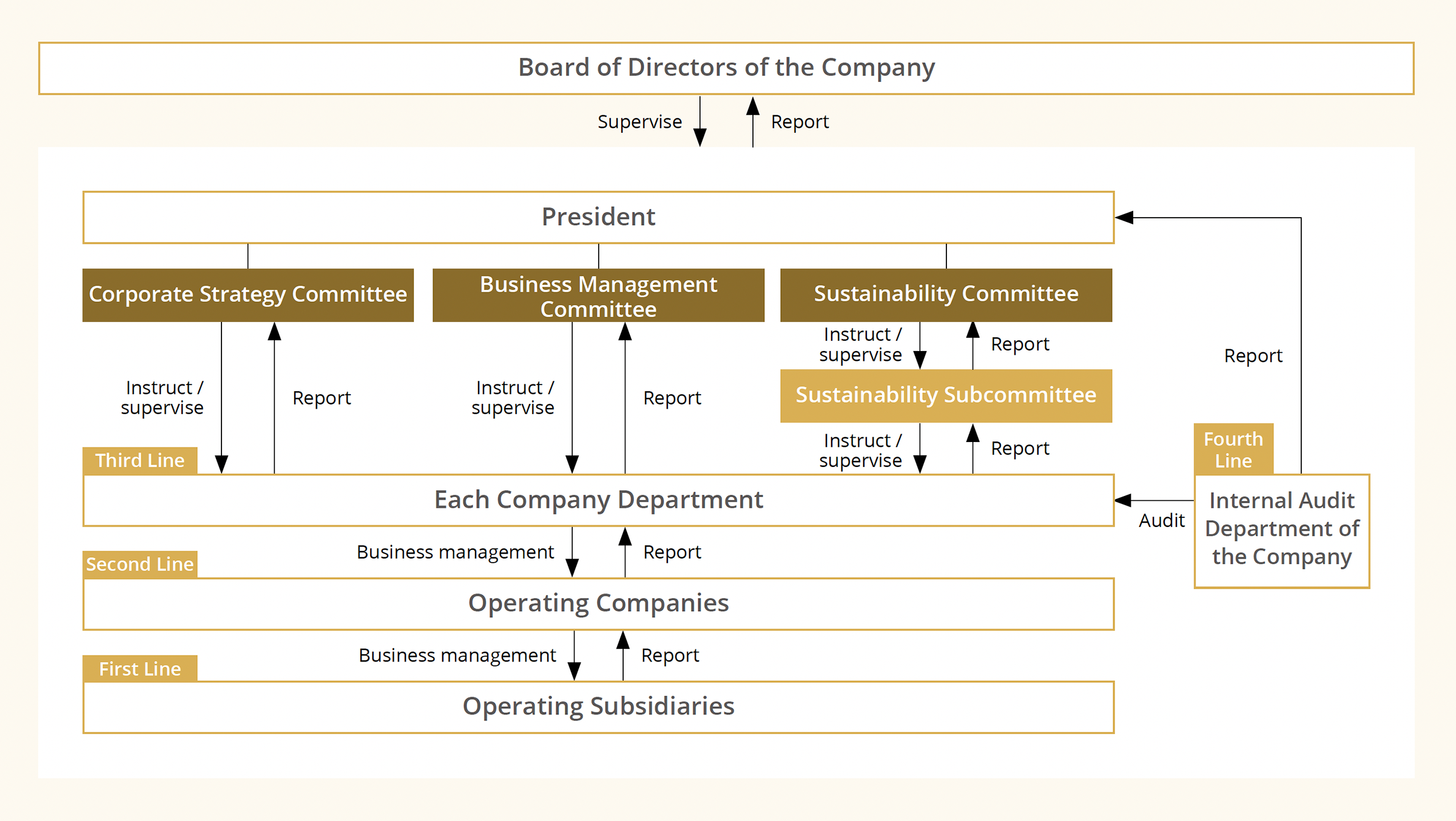ESG Library
Risk Management
Basic Approach
The DOWA Group engages in making its risk management more sophisticated to prevent situations that could have a major impact on its business and to prevent or mitigate damage in the unlikely event such a situation comes to pass. In addition, we will continue efforts to enhance and perfect our risk management flow, which involves identifying apparent and potential risks at each operating company, implementing countermeasures, reviewing them, and conducting audits.
Promotion System
The Group has established a risk management system based on the Four Lines Model for internal control, modeled on three lines of defense. The Operating subsidiaries responsible for production and other operations (first line) and the Operating companies that oversees them (second line) develop a risk management cycle that includes periodic risk assessments. In contrast, each DOWA Holdings division (third line) as the holding company provides necessary instructions, supervision, and support. The Internal Audit Department of DOWA Holdings (fourth line) conducts internal audits to evaluate the effectiveness of these measures. The risk management system is operated by the Sustainability Subcommittee, chaired by the director in charge of corporate planning, which is separated from the Audit & Supervisory Board.
Risk Management System Diagram

Definition and Assessment of Risk
The Group classifies risk into four major categories: economic risk, strategic risk, operational risk, and hazard risk. Each classification includes scenarios and integrated risk management regarding COSO and JISQ2001. The Corporate Strategy Committee and the Business Management Committee monitor all business risks, with a particular focus on strategic risks. In addition, the Sustainability Committee assesses and identifies risks classified as economic risks, operational risks, and hazard risks and then examines and discusses countermeasures. Any matters deemed important based on discussions at each committee are then reported to the Board of Directors, which accordingly supervises the response to these matters.
In FY 2022, each site identified and assessed the risks expected to impact business promotion in a manner consistent with these risk definitions. Responses to deal with priority risks were incorporated into the FY 2023 budget.
Classification of the Group’s Risks and Details of Discussions at Each Meeting

Risks That May Affect the DOWA Group’s Operating Results, Share Price, and Financial Position
| Classification | Description | Specific Risks | Response |
|---|---|---|---|
| Strategic Risks | Market Fluctuation Risks |
|
|
| Climate Change Risks |
|
|
|
| Economic Risks | Price Fluctuation Risks |
|
|
| Operational Risks | Operational Risks |
|
|
| Environmental Risks |
|
|
|
| Quality Risks |
|
|
|
| Labor Shortage Risks |
|
|
|
| Regulatory Risks |
|
|
|
| Hazard Risks | Information Security Risks |
|
|
Initiatives
Business Continuity Plans
In order to avoid or minimize any risks that could affect our ability to conduct business in times of emergency, we have formulated business continuity plans (BCPs) for each region and business location in the event of damaging earthquakes; other natural disasters, such as typhoons and torrential rains, which have been occurring with increasing frequency in recent years; and widespread pandemics. In addition, we regularly conduct drills based on scenario planning for large-scale disasters, such as an earthquake directly under the Tokyo metropolitan area, to prepare for crisis response as an organization. Since the DOWA Group primarily engages in business-to-business transactions, disruptions along the supply chain will have a severe impact on the production and sales activities of customers receiving our services or products. Therefore, through CSR procurement, we regularly confirm with our major suppliers that they have in place a BCP to ensure that we can restore and continue business promptly. In FY2023, outside experts will conduct a location risk survey at all production sites in Japan, assuming a wide range of natural disasters such as earthquakes, tsunamis, windstorms, floods, and landslides, and based on the results, we are reviewing the BCPs at each site.
Strengthening of Information Security
The strengthening of information security is positioned as one of the Group’s most important management issues. Under the leadership of management, we are working to address information security risks from both software and hardware perspectives. In FY 2021, we established a dedicated team to respond to cybersecurity incidents, and it quickly began tackling the issue. In FY 2022, we migrated to a security system that can centrally monitor the security status of computers used at each of the DOWA Group’s bases. We are also working to systematically improve employees’ understanding of security through methods that include raising awareness through training and study sessions.